
|
|
September 23, 2011
Sutro Tower, San Francisco, CA, 2005 and 2010
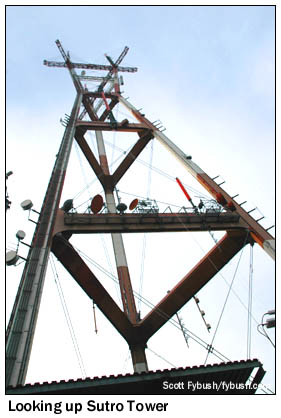
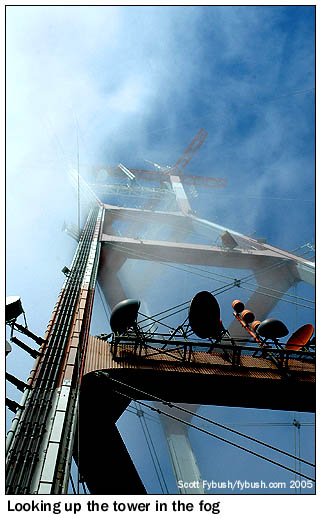 This
week on Site of the Week, we wrap up the recap of our 2010 visit
to San Francisco - and look back, as well, to some never-seen-here
photos from our last visit before that, back in 2005.
This
week on Site of the Week, we wrap up the recap of our 2010 visit
to San Francisco - and look back, as well, to some never-seen-here
photos from our last visit before that, back in 2005.
On both of those trips, we got to spend some quality time at the city's most distinctive tower site, the nearly 1000-foot self-supporting landmark called Sutro Tower that looms above the Western Addition neighborhood near the city's geographic center.
It's a site we featured once - from the outside - many years ago on Tower Site of the Week, back before we'd had the chance to get to know the engineers who'd unlock the gates to get us inside.
But Sutro Tower, which has stood here since 1973, went through some pretty dramatic changes between 2005 (seen on the left) and 2010 (seen on the right, with rather less fog!)
While it's hard to tell from these pictures, the top of the tower has been completely rebuilt in the last few years, with the original analog configuration from the 1970s and the makeshift interim digital setup of the early 2000s giving way to a new all-digital configuration.
I can't possibly chronicle the precise changes in the antenna layouts as well as David July has done over at his excellent SutroTower.org website, so I'll gladly point you there for all the specifics about who went where when.
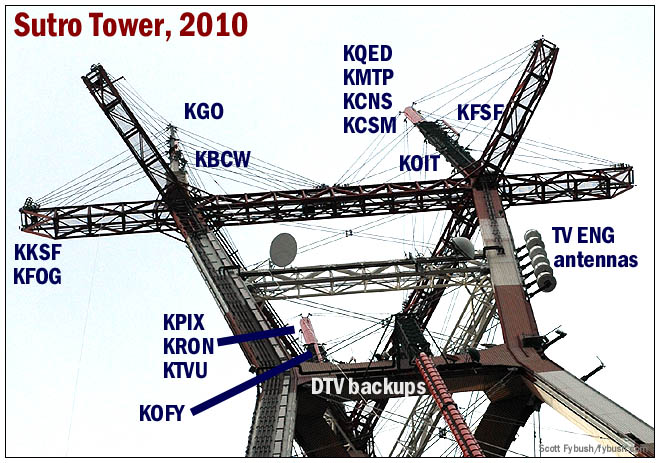 For
our purposes here, it will suffice to say that once the analog
TV stations (KTVU 2/Fox, KRON 4/ex-NBC, KPIX-TV 5/CBS, KGO-TV
7/ABC, KQED-TV 9/PBS, indies KOFY-TV 20, KMTP 32, KCNS 38; KBCW
44/CW and KFSF 66/Telefutura) went dark here in June 2009, the
weeks and months that followed were a blur of activity here as
those analog antennas were removed from the three spires at the
top of the tower and replaced with a new grouping of five antennas
serving all ten of the stations that had previously used the
tower, as well as public broadcaster KCSM-TV, whose analog operation
had been on Mount San Bruno.
For
our purposes here, it will suffice to say that once the analog
TV stations (KTVU 2/Fox, KRON 4/ex-NBC, KPIX-TV 5/CBS, KGO-TV
7/ABC, KQED-TV 9/PBS, indies KOFY-TV 20, KMTP 32, KCNS 38; KBCW
44/CW and KFSF 66/Telefutura) went dark here in June 2009, the
weeks and months that followed were a blur of activity here as
those analog antennas were removed from the three spires at the
top of the tower and replaced with a new grouping of five antennas
serving all ten of the stations that had previously used the
tower, as well as public broadcaster KCSM-TV, whose analog operation
had been on Mount San Bruno.
(The new roster runs as follows: KGO-TV, the lone VHF holdout, remains on channel 7 above the KBCW [RF 45] antenna; a master antenna for KPIX [RF 29], KRON [RF 38] and KTVU [RF 44] sits above a solo antenna for KOFY [RF 19] on another mast; the third holds a master antenna for KQED [RF 30], KMTP [RF 33], KCNS [RF 39] and KCSM [RF 43] above individual antennas for KFSF [RF 34] and KOIT (96.5); separate FM antennas for KKSF (103.7) and KFOG (104.5) are at the end of one of the top crossbars.
Most of those DTV signals had been operating from a temporary stack of antennas that can be seen through the fog in the 2005 photo above at left, hanging from the center of the top bar of the tower. By the time we returned in January 2010, the antenna stack was gone, but the crossbar that supported it at the bottom remained in place, holding the antenna of KSOL (98.9). A new stack of auxiliary DTV antennas hangs from the side just below the "waist" of the tower, clearly visible in the 2010 photo above at right.
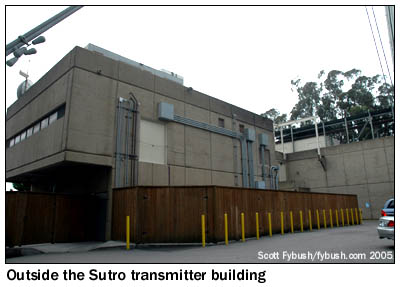 |
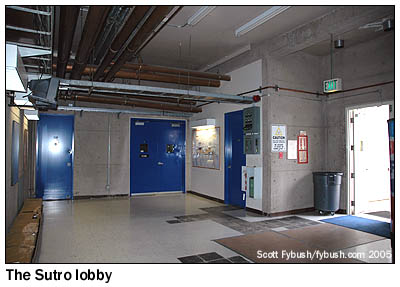 |
Shall we go inside? Once we've found the elusive "1 La Avanzada Street" (the "street" is really a fairly short driveway that leads up from a winding residential road to the transmitter site gate), we're buzzed in to park by one tower leg and make our way into the poured-concrete three-story monolith that houses all the transmitters here, each in its own individual room behind a blue door. The double-door just off the lobby in the photo above, for instance, leads to the KCSM room; down the hallway to our left as we shot the lobby photo above are the rooms of KOFY-TV and KTVU - and we got to see the latter just before the end of its analog days.
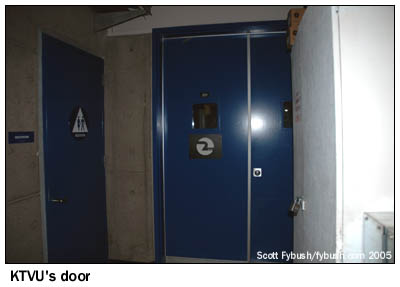
|
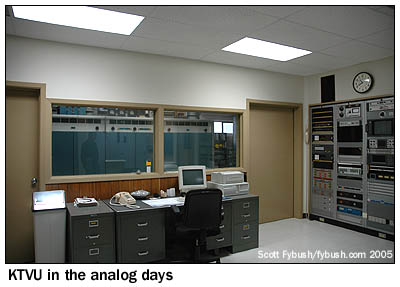
|
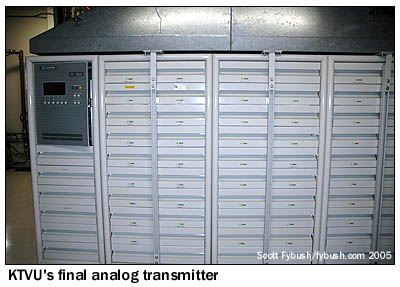
|
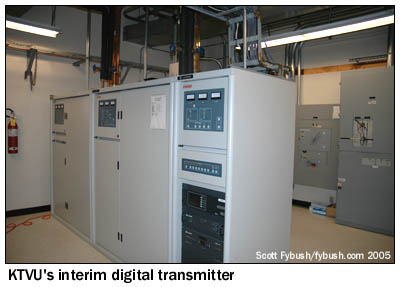
|
The commercial VHF stations that partnered to form Sutro Tower, Inc. in the late 1960s to build the tower ended up with the best real estate inside the transmitter building, too: KTVU and its partners KRON and KGO-TV each enjoy big suites of transmitter rooms right there on the main ("second") floor. (The fourth equal partner in the tower company, KPIX, chose a suite upstairs on the third floor.)
KTVU's suite starts with an engineering office that looked through big windows into the suite where that magnificent old RCA analog transmitter sat. The RCA was silent even in 2005, replaced by the smaller footprint of a Harris Platinum solid-state transmitter (above left); it, in turn, was in the process of being supplanted by DTV, with a Harris digital transmitter operating on KTVU's interim channel 56 allocation.
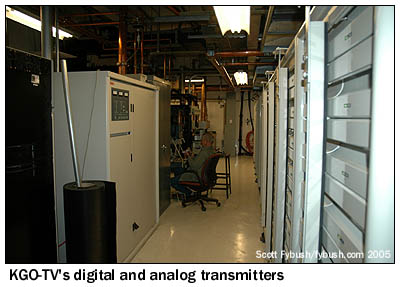
|
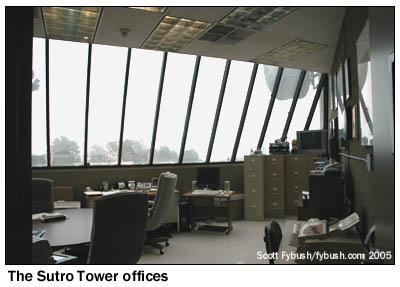
|
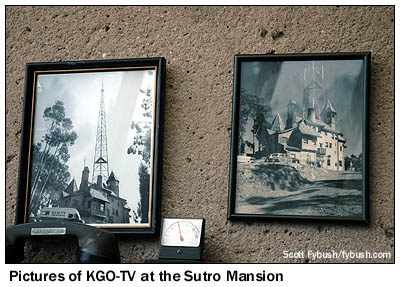 Returning
to that lobby picture above, KGO-TV and KRON are both down another
hallway behind us; in 2005, KGO-TV was also running Harris digital
transmitters (on interim channel 24) and Platinum analog; I suspect
the analog transmitter simply had its exciter and filters changed
out when ABC moved KGO-TV to digital 7 after the transition.
Returning
to that lobby picture above, KGO-TV and KRON are both down another
hallway behind us; in 2005, KGO-TV was also running Harris digital
transmitters (on interim channel 24) and Platinum analog; I suspect
the analog transmitter simply had its exciter and filters changed
out when ABC moved KGO-TV to digital 7 after the transition.
The Sutro Tower, Inc. offices are up on the third floor beneath a sloping glass window; on the walls are pictures of the hill's prior configuration, showing the old Sutro Mansion and the 500-foot tower that KGO-TV built here in 1949 when it signed on.
(KPIX was here, too, beginning in the 1950s, as apparently was the short-lived KSAN-TV 32; KTVU, KRON, KQED and what's now KOFY and KBCW all moved down from San Bruno in 1973 when the mansio was demolished and the new tower was completed.)
Most of the former UHF stations are up here on the third floor, too, and Telefutura's KFSF is a typical example, shown here in 2005 while its analog and digital signals were both still on the air.
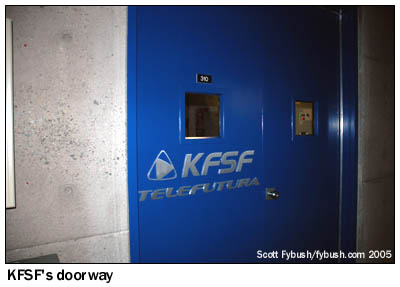
|
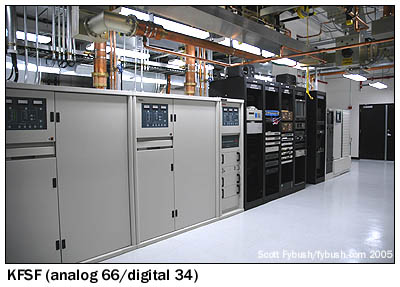
|
From the third floor, we head back down to the first floor, which is actually the basement. Many of the tower's non-broadcast tenants are down here - the old Viacom Cable took up much of the space on this floor, for instance - but the FM signals that use the tower are here as well, lined up in small rooms down one hallway.
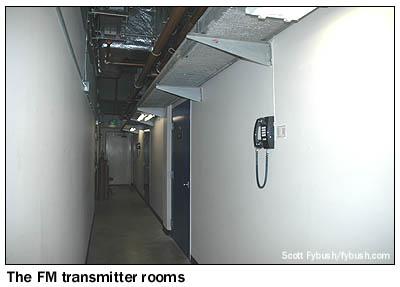
|
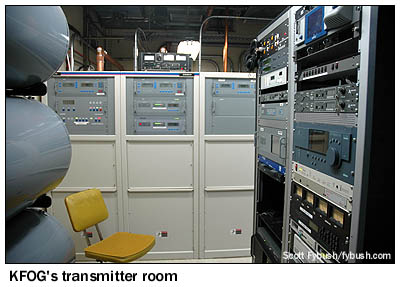
|
While most FM stations stayed put on Mount San Bruno even after Sutro opened for business, one of the TV stations that moved here brought its sister FM along: what's now KOIT (96.5) is the old KRON-FM. KKSF (103.7), the former KGO-FM, has been here all along, while KFOG (104.5) and what's now KSOL (98.9) moved here from other sites within the city.
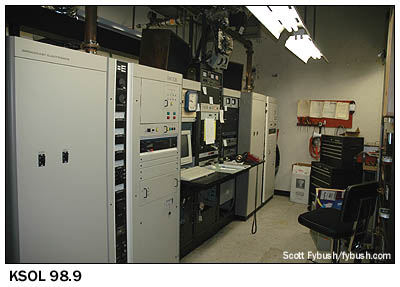
|
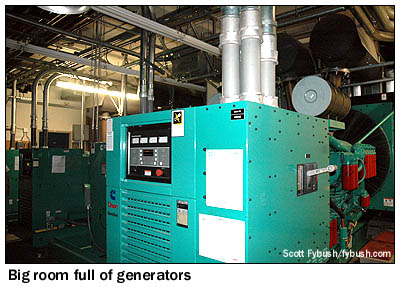
|
The first floor is also where the power for the tower is handled: there's a big generator room with a bank of high-power generators that keep the hill humming on the rare occasions when shore power goes out - and through a doorway from that room is one of the tunnels that carries transmission lines over to the north leg of the tower.
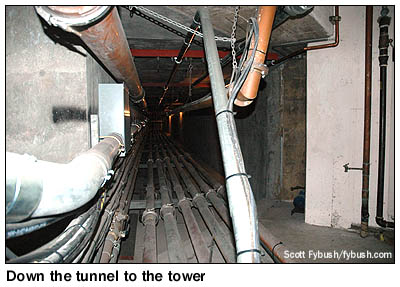
|
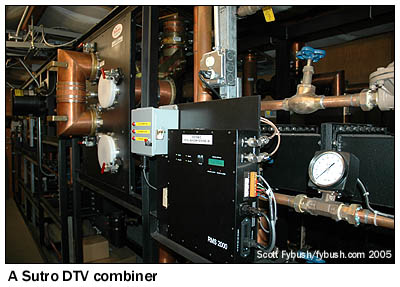
|
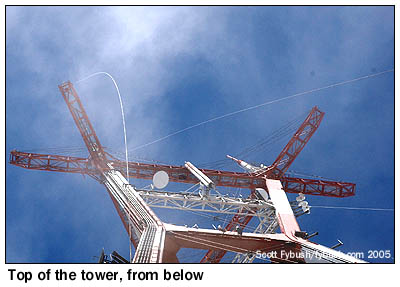 And
from here, we head back up to the third floor and out
to the roof for a peek at one of the combiners that were installed
during the DTV transition to feed the interim antennas (center,
right) hung from one of the top bars of the tower.
And
from here, we head back up to the third floor and out
to the roof for a peek at one of the combiners that were installed
during the DTV transition to feed the interim antennas (center,
right) hung from one of the top bars of the tower.
Shown here is "system C," which in the transition era was used to combine KTVU (56), KCNS (39) and KCSM (43).
(In the photo at right, you can clearly see the interim DTV antenna stack protruding from one of the top bars of the tower; the mast above it at right was then carrying KQED, KMTP, KFSF and KOIT-FM.)
And since it doesn't get any better than Sutro Tower when it comes to San Francisco towers, there's no better place to leave the Bay Area for now. We'll be back again sometime soon, we hope, to see more of the rooms at Sutro and perhaps even to get some nice fog-free closeups of the rebuilt top of the tower. And while we're waiting, don't forget to check in as well over at Tophour.com to hear lots and lots of San Francisco legal IDs!

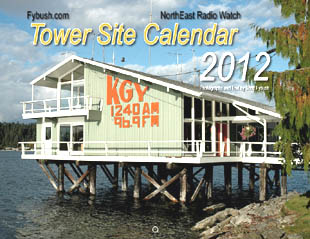 - Find out when the new Tower Site is posted,
and much more! Follow us on Twitter @NERadioWatch - and don't miss your very first chance to
order the new Tower Site Calendar 2012, now available at the
Fybush.com
store!
- Find out when the new Tower Site is posted,
and much more! Follow us on Twitter @NERadioWatch - and don't miss your very first chance to
order the new Tower Site Calendar 2012, now available at the
Fybush.com
store!- Previous Site of the Week: Mount San Bruno, San Francisco
- Next Week: FM 128, Boston
- Site of the Week INDEX!
- How can you help support Site of the Week? Click here!
- Submit your suggestions for a future Site of the Week!
